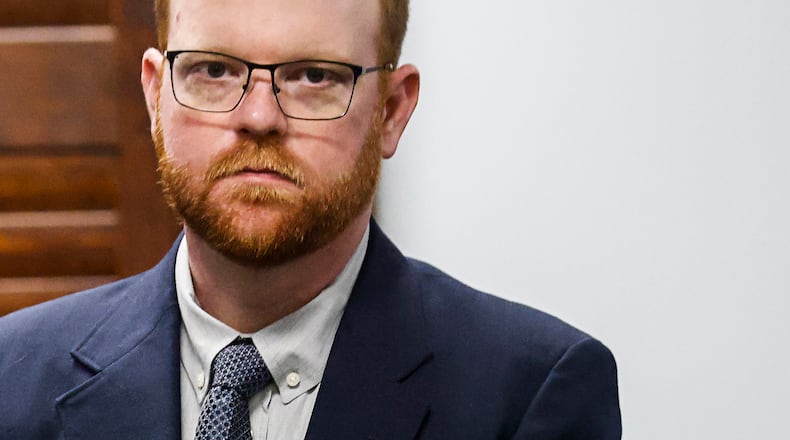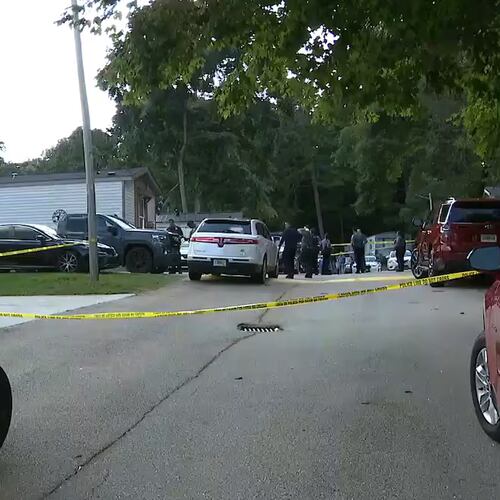Travis McMichael stared straight ahead Thursday afternoon as jurors were shown graphic photos taken during Ahmaud Arbery’s autopsy.
Dr. Edmund Donoghue, the renowned forensic pathologist who conducted Arbery’s examination the day after he was killed, walked them through the grievous injuries the 25-year-old suffered after being twice shot at close range during a struggle over McMichael’s 12-gauge shotgun.
As he testified in the last year’s state trial, Donoghue explained the first shotgun blast alone would have killed Arbery. Travis McMichael fired three shotgun blasts, but the second shot was a “complete miss,” the GBI pathologist explained from the stand. Arbery’s injuries included a gaping wound to the center of his chest, a large graze wound to his right wrist, a fractured humerus, five fractured ribs and a paralyzed left arm.
None of the pellets struck Arbery’s heart, and the medical examiner explained that it was Arbery’s “fight or flight reaction” that allowed him to keep moving even after the fatal blasts.
The reaction sent adrenaline coursing through Arbery’s body, he told prosecutor Bobbi Bernstein, which “shuts down blood supply to the gut and gets you ready to fight or flee.”
Some of the buckshot pellets passed through Arbery’s body, the autopsy showed. Others remained lodged in his torso and shoulder.
Travis McMichael, his father Greg McMichael and their neighbor William “Roddie” Bryan were convicted of Arbery’s murder last fall in a state court trial. The three men are now on trial in federal court charged with hate crimes.
On Wednesday, prosecutors introduced explosive evidence of racist messages and social media posts sent by the three defendants as the government tried to convince the jury of three Black, eight white and one Hispanic person that the defendants’ actions on Feb. 23, 2020, were motivated by racism.
U.S. District Judge Lisa Godbey Wood said Thursday that one of the jurors asked a marshal if federal funds were available for counseling and was told there are.
Arbery had been seen entering a vacant home under construction several times in the months before his death. Larry English, the owner of the home, lived about 80 miles away in Douglas. He had installed motion-activated surveillance cameras that alerted him when someone was on his property, concerned about thefts and liability if someone fell off the dock behind his home and into the river.
Glynn County Police Officer Robert Rash said he was first sent the surveillance footage of Arbery walking around the home in October 2019.
Others had also been seen on the property, including a neighbor’s children and a white couple who entered the home in November, Rash testified. In December, he approached Greg McMichael in his front yard and showed him images of Arbery.
Rash said given Greg McMichael’s law enforcement experience, he thought he would make an “excellent witness” if he ever saw Arbery in the neighborhood and called the police.
Rash said if he had been able to identify Arbery, he would have simply been given a trespass warning and asked not to return. He also told the McMichaels there was no evidence that Arbery had never stolen anything from the vacant home 12 days before the shooting.
On Feb. 11, 2021, Travis McMichael called 911 after seeing Arbery go into the home. He told the dispatcher the man he spotted appeared to be armed, prompting a large police response.
“I don’t know if he’s armed or not, but he looked like — he was acting like he was,” Travis McMichael said on the call. “So be mindful of that.”
Rash, who responded that night, showed the father and son the surveillance footage that English sent him. He explained that Arbery had been seen in the house before, but never disturbed anything.
Bernstein asked Rash what he expected Greg McMichael to do if he ever saw the man, and the patrol officer told her he only expected McMichael to call the cops.
“Did you think he would get in a truck and go after him?” she asked. “Did you expect him to arm himself? Did you expect him to point a gun (at Arbery) and threaten to blow his head off?”
“I did not,” Rash responded to all three of her questions.
On cross examination, Greg McMichael’s attorney asked the officer if he ever heard his client say anything racist about Arbery.
“Did Mr. McMichael ever use any type of racial epithet to describe Mr. Arbery,” A.J. Balbo asked.
Rash said he did not.
About the Author
The Latest
Featured



